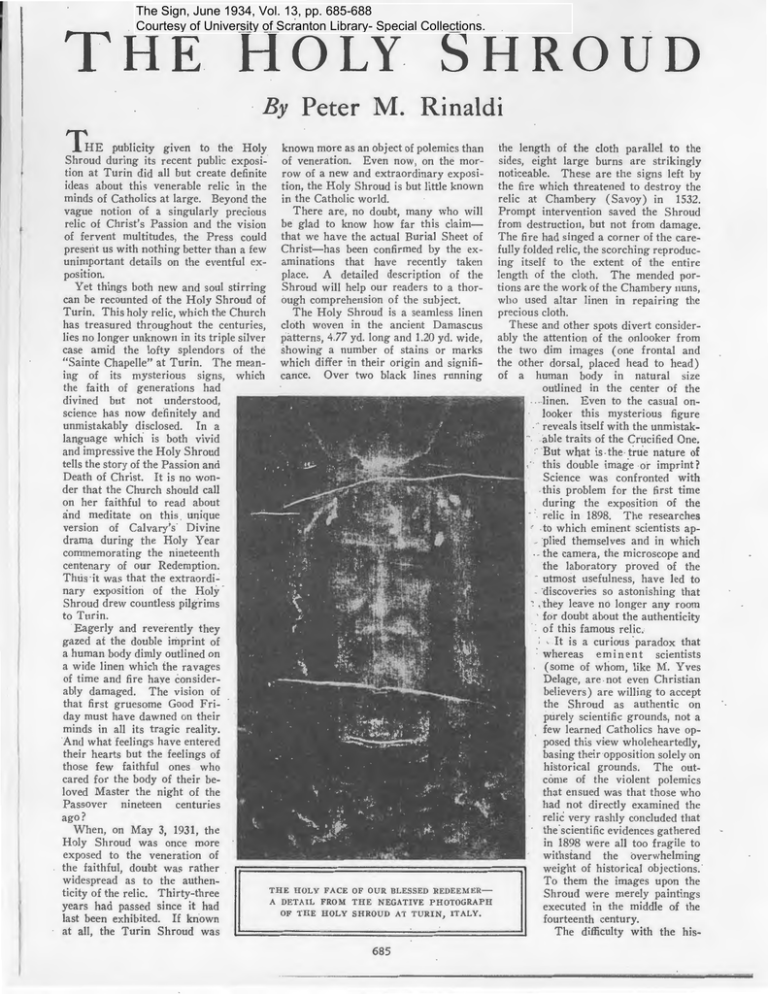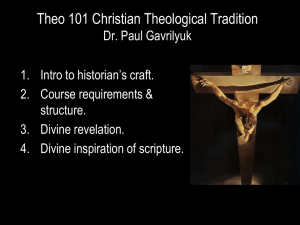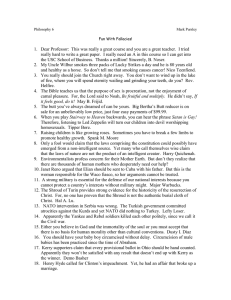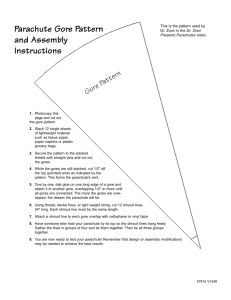The Sign, June 1934 Vol. 13, pp. 685
advertisement

The Sign, June 1934, Vol. 13, pp. 685-688 Courtesy of University of Scranton Library- Special Collections. THE HOLY SHROUD By Peter M. Rinaldi THE publicity given to the Holy known more as an object of polemics than Shroud during its recent public exposi- of veneration. Even now, on the mortion at Turin did all but create definite row of a new and extraordinary exposiideas about this venerable relic in the tion, the Holy Shroud is but little known minds of Catholics at large. Beyond the in the Catholic world. vague notion of a singularly precious There are, no doubt, many who will relic of Christ's Passion and the vision be glad to know how far this claimof fervent multitudes, the Press could that we have the actual Burial Sheet of present us with nothing better than a few Christ-has been confirmed by the exunimportant details on the eventful ex- aminations that have recently taken position. place. A detailed desct·iption of the Yet things both new and soul stirring Shroud will help our readers to a thorcan be recounted of the Holy Shroud of ough comprehension of the subject. Turin. This holy relic, which the Church The Holy Shroud is a seamless linen has treasured throughout the centuries, cloth woven in the ancient Damascus lies no longer unknown in its triple silver patterns, 4.77 yd. long and 1.20 yd. wide, case amid the lofty splendors of the showing a number of stains or marks "Sainte Chapelle" at Turin. The mean- which differ in their origin and signifiing of its mysterious signs, which cance. Over two black lines running the faith of generations had divined but not understood, science has now definitely and unmistakably disclosed. In a language which is both vivid and impressive the Holy Shroud tells the story of the Passion and Death of Christ. It is no wonder that the Church should call on her faithful to read about and meditate on this . unique version of Calvary's Divine drama during the Holy Year commemorating the nineteenth centenary of our Redemption. Thtis it wa that the extraordinary exposition of the Holy Shroud drew countless pilgrims to Turin. Eagerly and reverently they gazed at the double imprint of a human body dimly outlined on a wide linen which the ravages of time and fire have considerably damaged. The vision of that first gruesome Good Friday must have dawned on their minds in all its tragic reality. And what feelings have entered their hearts but the feelings of those few faithful ones who cared for the body of their beloved Master the night of the Passover nineteen centuries ago? When, on May 3, 1931, the Holy Shroud was once more exposed to the veneration of the faithful, doubt was rather widespread as to the authenTHE HOLY FACE OF OUR BLESSED REDEEMERticity of the relic. Thirty-three A DETAIL FROM TilE NEGATIVE PHOTOGRAPH years had passed since it had OF TilE HOLY SIIROUD AT TURIN, ITALY. last been exhibited. If known at all, the Turin Shroud was 685 the length of the cloth parallel to the sides, eight large burns are strikingly noticeable. These are the signs left by the fire which threatened to destroy the relic at Chambery (Savoy) in 1532. Prompt intervention saved the Shroud from destruction, but not from damage. The fire had singed a corner of the carefully folded relic, the scorching reproducing itself to the extent of the entire length of the cloth. The mended portions are the work of the Chambery nuns, who used altar linen in repairing the precious cloth. These and other spots divert considerably the attention of the onlooker from the two dim images (one frontal and the other dorsal, placed head to head) of a human body in natural size outlined in the center of the -linen. Even to the casual onlooker this mysterious figure - reveals itself with the unmistakable traits of the Crucified One. - But what is -the-true nature of this double image or imprint? Science was confronted with this problem for the f-irst time during the exposition of the rdic in 1898. The researches to which eminent scientists applied themselves and in which -- the camera, the microscope and the laboratory proved of the - utmost usefulness, have led to discoveries so astonishing that ; . they leave no longer any room for doubt about the authenticity of this famous relic. It is a curious -paradox that whereas eminent scientists (some of whom, like M. Yves Delage, are not even Christian believers) are willing to accept the Shroud as authentic on purely scientific grounds, not a few learned Catholics have opposed this view wholeheartedly, basing their opposition solely on historical gwunds. The outcome of the violent polemics that ensued was that those who had not directly examined the relic very rashly concluded that the -scientific evidences gathered in 1898 were all too fragile to withstand the overwhelming weight of historical objections. To them the images upon the Shroud were merely paintings executed in the middle of the fourteenth century. The difficulty with the his- 6$6 THE t SIGN torian of the Shroud is apparently very serious. His efforts to reconstruct the chain of events that links the Turin Shroud with Christ's burial have literally come to nothing. The chronological data at his service are all too scarce and often even doubtful. The few documents that directly bear on the subject would seem to discourage any serious attempt to prove the Shroud's authenticity on merely historical grounds. Besides, it must be stated, other "shrouds" are known. to have existed. any rate if unaided by any elaborate mechanical device. "3. In the fourteenth century in France anatomy was not understood, and nothing was known of the circulation of the blood. But here the anatomical detail and proportion is exact, the behavior of blood flowing from a wound is true to nature, and the contrast between living blood and dead blood is duly preserved. Even the characteristic way in which a clot of blood dries, the coloring matter thicker on the circumference than in the center, is truly represented on the Shroud, though it takes the microscope to reveal it. But the reali sm of the fourteenth century was not of this kind; science had not attained to such details of knowledge, nor did men do work that only the microscope could test; the microscope itself had not been invented! "4. The fourth reasoi1 carries conviction to the mind even more readily than those three already g iven. It is that the figures upon the Shroud are shown reversed in light and shade, something after the manner of a photographed negative. If they are photographed they produce upon the plate a positive picture, with light and shade more as we 1re accustomed to see it. Even the expression upon the face is perfect. But no human being, even now, could paint in this way, not even if. he were an expert retoucher of photographs. Such a one might be able to produce a passable representation of a human body in negative, butto preserve so delicate a thing as the expression on a face while thus reversing the light and shade is quite beyond human skill. If that is so even today, when photography has made us familiar with the phenomena of inverted light and shade, how much was it so in the fourteenth century, when the very idea had not yet been thought of. Nor, even if it had been possible, could there be any conceivable motive which would have led a painter to work in this way, and make his wod< so hard to understand. "These four considerations are sufficient to put completely out of court the theory that the Shroud is nothing but' ·a medieval painting. It should never be heard of again." T HESE objections, which the opponents of the authenticity advanced with so much certainty, face to face with the more recent examinations of the relic, have broken down irrevocably. In archeology when an object can supply its own authentication it is of small consequence what may have been its history. Now the evidences gathered from the objective examination of the Turin Shroud are more than sufficient to warrant its claim to authenticity. This explains why opposing scarce and doubtful literary documents to scientific evidences of the highest import has become, in the case of the Holy Shroud, a rather discomforting task. Doctor Arthur S. Barnes who, to an extensive knowledge of the Shroud's literature, joins the experience of a personal examination of the Relic, thus sums up the scientific evidences gathered in 1898 and fully confirmed during the more recent expositions: "There are four reasons, each of·which could be decisive by itself, and which, taken together, make any further suggestion of painting quite inadmissible. They· are as follows: "I. The process of painting on a fabric involves the deposit of solid particles of coloring matter upon the threads, so that these latter become partially or entirely hidden. But in the case of the Shroud every thread is visible, and no trace of solid extraneous matter can be detected even by microscopic examination. The threads themselves are stained more or less throughout, so that the same figures, fainter in coloring but otherwise identical, appear on the other side. Not thus was any human painting done in the fourteenth century, or indeed at any other time. "2. Human work, however minute, necessarily shows outline and shading. It may be so fine as completely to delude the unaided eye, but its nature at once becomes manifest when it is put under the microscope. But these figures have no outline and no trace of shading. The coloring becomes more or less intense by quite imperceptible degrees. The edges fade away into the general fabric so that it is impossible to say where the tint begins and. where it ends. That effect is characteristic of natural processes; it is quite unattainable by human effort, at Vol. 13. No. 11 T THE HOLY SHROUD AS SEEN BY THOUSANDS DURING ITS RECENT EXPOSITION AT TURIN. THE FIGURE OUTLINED ON THE CLOTH RESEMBLES A PHOTOGRAPHIC NEGATIVE, HE double imprint upon the Shroud has, then, all the characteristics of a photographic negative (light and shade reversed, inverted positions, etc.) so that if photographed it produces on the plate the positive picture of a man exact in every detail, proportioned, artistically beautiful and endowed with a marvelous expression. Through photography we have the surest identification of this mysterious image and the ir'tefutable proof of the Shroud's authenticity. The magnificent photographs, taken in 1931 by competent Signor Enrie of Turin and issued with ecclesiastical authority, have once more disclosed the June, 1934 THE t SIGN astonishing characters of the figures of the Shroud. The stain images of the linen become on the photographic negative (plate) a perfect portrait of a dead body, and evidently enough of the body of a man who has suffered crucifixion after a cruel scourging; who has been crowned with thorns and whose side has been pierced with a lance. The face which on the Shroud is quite meaningless, reversed as it is in light and shade, takes on the photographic negative the wondrous expression which has excited the admiration of countless artists. The wound which is to be seen in the left wrist (the right hand is covered ove1· by the left), while against all pictorial traditions, is in perfect harmony with anatomical requi sites. The rivulets of blood visible on both forearms would imply that the arms of the Crucified One were raised above the head. The arms had, therefore, to support much of the weight of the body. The long nail, driven through the lower part of the palm, would have to be slanted downwards that it might hold the better and not tear through the flesh. The wound on the back of the hand would naturally come out on the wrist. Yves Delage, non-Catholic and nonChristian as he was, "Who but the Christ could impress this image on the Shroud?" Some there are, even among the more learned admi1·ers of the Holy Shroud, who would not entirely eliminate the supernatural factor in dealing with this relic. They see something more than the merely ordinary course of nature in the way with which God was pleased to leave to His Church so striking a memorial of the Passion of His Son. The scienti st, however, believes himself to have reached a very definite conclusion as to the origin of the Shroud's images. Whatever providential guiding there may have been, their origin, he holds, was natural. C T HE wounds of the feet are strikingly noticeable on the back image, part of the linen having been folded back from the heels so that it lay along the bloodstained soles. The wound of the side is clearly situated on the right (in proximity of the mended portion of the I in en). The flowing of the blood is true to nature. Doctor P. Barbet of Paris can infer the trail of the lance from the position of the wound. "It penetrated between the fifth and sixth rib, bored through the right lung and pierced the right auricle of the heart." The scourge has left traces of its gruesome work over the entire body; yet the bruises are particularly numerous and distinct on the dorsal region. Their shape, number (about 80) and distribution (two by two) enable us to infe1· that the condemned was inflicted the forty legal st1'okes and that the two whip lashes were provided with a metal strip. But the eye is irresistibly drawn to the face of this mysterious figure . It is a true photog raphic portrait because it has resulted from a negative (the stained image of the Shroud) . The feature s are as impressive as they are definite : the white showing blood marks on the forehead tell of the crown of thorns; the long semitic nose shows a pronounced tumefaction ; the right cheek is swollen; the lower lip slightly protruding; the hair stiffened by the sweat and the trickling blood. Yet neither the insults of the mob no1· the agony of an excruciating death has altered the calm, serene, majestic expression ·of this incomparable countenance. One can ·only cry out with Professor 687 THE HOLY SHROUD AS IT APPEARS ON THE PHOTOGRAPHIC NEGATIVE PLATE . THE FIGURE IS NO LONGER NEGATIVE, BUT HAS TURNED POSITIVE. NOTE THE DISTINCT BODY. LEARLY, these images are not the work of an artist; consequently they can only have been caused by some influence proceeding from an actual body which was laid upon one half of the sheet and then covered with the remaining portion. But under what circumstances can a dead body produce upon the linen which surrounds it definite images of itself such as we see upon the Shroud? Two are the requisites determined by laboratory experiments: first, a coloring substance . on the linen, which being thus made susceptible of impression, would act much like the sensitized plate in the camera; second, a fluid emanated from the body which determining a reaction with the coloring substances causes indelible stains to be formed on the linen. This fluid is evidently a gas since it acts at a distance and by osmosis through whatever linen cloths that might separate the sheet from direct contad with the skin. Furthermore it must draw its origin from the blood. The stain images of the Shroud show that the emanation has been present in greater activit'y where the flesh was bruised and most of all in the blood itself. Now physiology points to urea, preser.t both in the clotted blood and in the sweat, as a substance which yield s first carbonated ammonia and then ammoniacal gases. Experiments have shown that alkaline substances, such as ammonia, react with a principle of the aloe; forming a reel-brown colored and coloring substance. It was following these considerations and the Gospel narratives that Paul Vignon, Professor of Biology in the Institut Catholique of Paris, framed his famous theory of "contact" experimented and accepted as the most probable explanation of the Shroud's images by eminent professors of the Sorbonne University. The body of the Redeemer was given a hurried and temporary burial. We insist on this fact because, while it answers to truth, it is of capital importance to the theory. "The sabbath drew on" (Luke 23, 54) 688 THE and the usual ceremonies had to be postponed to the first clay after the hallowed season of rest. The fact that the women "returning prepared spices and ointments" (Lnke 23, 56) implies that the body had not been anointed at all. St. John says that "they bound it in linen cloths with spices, as the manner of the Jews is to bury." (! ohn 19, 40.) He does not say that they went through all the operations after the manner of the Jews. It is rather arbitrary, then, to infer from that text that the body was washed, anointed and wrapt with the long linen bands. What would the women come to the tomb for early on Sunday morning? Still unprepared for the definite burial, the Body of the Savior was laid upon one half of a "clean linen cloth" and then covered with the other half. This linen, purchased by Joseph of Arimathea on the spur of the moment (Marll 15, 46), had been profusely spread with the spices (a compound of myrrh and aloes ground and mixed together) provided by Nicodemus (John 19, 39). It is quite certain that some smaller linens were used besides the wide sheet. The hands, reverently composed together, were bound with a strip of cloth. The napkin referred to by St. John (! ohn 20, 7) was probably put about the head to hold the chin into position. A cloth was quite certainly placed about the loins where the hands rested. Joseph, after having thus "wrapped the body in the clean linen cloth laid it in his own new monument" (Matt . 27, t Vol. 13. No. 11 SIGN 60) ; "there," adds St. John, "because of the parasceve of the Jews, because the sepulchre was nigh at hand." It was, then, but a temporary deposition they provided for the body of their beloved Master, and this in view of the definite burial they would give It soon after the hallowed repose of the Great Paschal Sabbath. T HE Body which the Shroud enveloped was exceptionally fit to produce the amount of ammonia necessary for the reaction. An agony of sorrow and of dismay had drawn from its pores a heavy perspiration of blood, particles of which remained hidden along the channels of the sweat glands. Then, the scourging, the crowning with thorns, the tragic journey up Calvary, the crucifixion, the violent death after hours of untold sufferings. These were the determining causes of an abundant emanation of ammoniacal gases which, developing from the dissolving urea, reacted with the aloe on the Shroud. The ammoniacal vapors did not equally react on the different parts of the sheet. The linen was stained through and through; very strongly at those points where there had been actual contact, less intensely precisely in porportion to the distance which separated that particular portion of the Body from the surface of the sheet. The blood and the bruises acted most strongly of all, and made darker and redder stains. The images thus formed present the appearance of a photographic negative, with light and shade reversed from the effect ordinarily produced upon our eyes. As to the probability of this theory, which still enjoys the favor of many learned admirers of the Turin Relic, we will observe with Doctor Barnes that to reproduce the conditions of the crucifixion is obviously impossible. Once it is granted that the images like those on the Shroud may conceivably have been caused by slow chemical action of this kind, there is little to be gained by further experiment. But it will be well to note that all the four points, mentioned before in order to prove that in the case of the Shroud we are not dealing with any human production, are precisely those which would certainly be present in any such work of nature. Does the theory of contact exclude the supernatural factor? When we think of the unusual process that has caused the images on the Shroud and consider all the circumstances that were necessary for their production, we cannot but admire the Providence of God Who was pleased to leave to the Church and to the world the material document of the Passion and Death of Christ. And if by a new and no less admirable trait of His Providence, it has pleased Him to reveal to us the figure of the suffering God-Man, it is doubtlessly in order to call us to a greater and deeper appreciation of His love for us. "He hath loved us, and hath delivered himself for us." (Eph. 5, 2.) UNCLE SAM: INVESTOR The Government Enters the Investment Market By Gerhard Hirschfeld N GW that the wheels of industry are turning again, that more men go to work and larger pay envelopes find their way into millions of happy homes, old friends are showing up again: doubts in the Government's wisdom, complaints about retarding what is conveniently ca1led the natural process of business recovery, and last, but by no means least, a rather tardy self-awakening of private business, proudly proclaiming its ability to pull itself up by its own bootstraps. We have not heard much from private business since the spring of 1933 when it was not precisely ambitious to get anywhere, except out of the red. Occasionally, it was accused of code violation; more often, it showed itself ready to co- operate, or, at least, careful not to take any direct attitude toward, in favor or against, the New Deal, as long as the course of business was not more definitely ascertained. The time has come now when even conservative business interests admit the general improvement that has taken place in almost every field and branch. And, with the assurance of a limited amount of business recovery, there has come an also limited amount of opposition on the part of private business. There is, as you can convince yourself in your daily routine of news digesting, opposition to further restriction of production, to further reduction of working hours, to code administration, and many other prominent New Deal measures. One of the more important attacks deals with the complaint that the Government is competing with private capital in seeking investment opportunities. The recovery program absorbs many a million dollars which, in normal years, would have gone directly to industry. By the middle of next year, it is estimated, the Government will have spent more than ten billion dollars for purposes which, in former years, attracted private capital, for instance, loans to banks, to farmers, to home owners, railroads, mortgage companies, power trusts, and the like. There is truth in this charge. The Government is, indeed, in-


